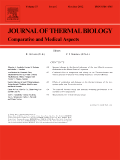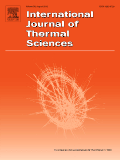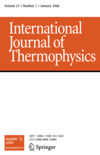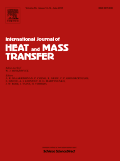
JOURNAL OF THERMAL BIOLOGY
Scope & Guideline
Unraveling the Thermal Threads of Biological Systems
Introduction
Aims and Scopes
- Thermal Physiology and Adaptation:
Research on how organisms physiologically adapt to varying temperatures, including mechanisms of thermal tolerance and acclimatization. - Thermal Stress and Its Impact:
Studies examining the effects of thermal stress on health, performance, and reproductive success in various species, particularly in the context of climate change. - Ecological and Evolutionary Perspectives:
Investigations into how temperature influences ecological interactions, species distributions, and evolutionary adaptations. - Technological Applications in Thermal Biology:
Development and application of technologies such as infrared thermography for assessing thermal responses and monitoring in both wildlife and domestic animals. - Thermal Management Strategies:
Research on strategies for mitigating adverse effects of heat stress in agricultural and industrial settings, focusing on improving animal welfare and productivity.
Trending and Emerging
- Climate Change and Thermal Stress:
Research addressing the implications of climate change on thermal stress responses in various organisms has surged, highlighting the urgency of understanding these dynamics in a warming world. - Use of Advanced Imaging Techniques:
The application of advanced imaging techniques, such as infrared thermography, for non-invasive assessments of thermal responses is rapidly gaining traction in both field and laboratory studies. - Focus on Behavioral Thermoregulation:
There is a growing emphasis on understanding behavioral adaptations to thermal stress, with studies exploring how animals modify their behaviors in response to thermal environments. - Interdisciplinary Approaches to Thermal Biology:
Collaborative research that combines thermal biology with fields such as genomics, bioinformatics, and ecology is on the rise, fostering comprehensive insights into thermal adaptation. - Thermal Biology in Agricultural Practices:
Research on applying thermal biology principles to improve livestock management and agricultural practices is becoming increasingly prominent, reflecting the need for sustainable agricultural solutions.
Declining or Waning
- Basic Mechanistic Studies:
There has been a noticeable decline in purely mechanistic studies that do not connect to broader ecological or physiological implications, as the field moves towards more integrative and applied research. - Historical Perspectives on Thermal Biology:
Research focusing on historical or retrospective analyses of thermal biology has decreased, possibly as current studies emphasize contemporary issues like climate change impacts. - Temperature Effects on Non-Model Organisms:
While still important, there is a waning interest in studying temperature effects on non-model organisms, as more emphasis is placed on economically or ecologically significant species.
Similar Journals

Heat Transfer
Unlocking the secrets of heat transfer for enhanced performance.Heat Transfer, published by WILEY, is a leading open-access journal dedicated to advancing the field of heat transfer science, encompassing innovative research and application across various domains. With an ISSN of 2688-4534 and an E-ISSN of 2688-4542, the journal aims to provide a platform for researchers to disseminate their findings from 2020 to 2024, focusing on condensed matter physics and fluid dynamics. Ranked in the Q2 category for both Condensed Matter Physics and Fluid Flow and Transfer Processes, it showcases articles that contribute significantly to the understanding and utilization of heat transfer mechanisms. Located in the United States at 111 River St, Hoboken, NJ 07030, the journal appeals to a diverse audience, including academic researchers, professionals in engineering, and students seeking to deepen their knowledge in thermal sciences. With a strong emphasis on accessibility, Heat Transfer promotes the exchange of ideas and experimental techniques, ultimately driving innovation and collaboration in the advancement of thermal management technologies.

INTERNATIONAL JOURNAL OF THERMAL SCIENCES
Elevating the discourse in thermal sciences.The INTERNATIONAL JOURNAL OF THERMAL SCIENCES is a premier academic journal published by ELSEVIER FRANCE-EDITIONS SCIENTIFIQUES MEDICALES ELSEVIER, focusing on cutting-edge research in the field of thermal sciences. With its ISSN 1290-0729 and E-ISSN 1778-4166, this journal has established itself as a crucial resource for scholars and professionals interested in the thermodynamic principles governing engineering and condensed matter physics. The journal is ranked Q1 in both Condensed Matter Physics and Engineering (miscellaneous), highlighting its exceptional quality and influence, as reflected in its impressive Scopus ranks: #32 out of 307 in General Engineering (89th percentile) and #57 out of 434 in Condensed Matter Physics (86th percentile). Researchers and students alike can benefit from the wealth of articles available, with access options designed to foster a wider dissemination of knowledge within the scientific community. Established in 1973 and ongoing through 2025, the journal invites contributions that advance the understanding of thermal phenomena and their applications, solidifying its importance in driving innovation and insight within these dynamic fields.

Journal of Experimental Zoology Part A-Ecological and Integrative Physiology
Advancing ecological insights through integrative physiology.The Journal of Experimental Zoology Part A - Ecological and Integrative Physiology, published by WILEY, is a distinguished peer-reviewed journal focusing on ecological and evolutionary physiology, providing a robust platform for research that bridges both ecological and integrative physiological concepts. With an impressive impact factor and recognition as a Q1 journal in both Animal Science and Zoology and Ecology, Evolution, Behavior and Systematics in 2023, it positions itself as a leader in advancing our understanding of organismal biology and environmental interactions. The journal is committed to open access, offering researchers and professionals worldwide the opportunity to share and disseminate their findings freely. Since its inception in 2017, it has rapidly gained prominence—ranking within the top percentiles of Scopus Ranks across several disciplines, including genetics and molecular biology. This not only underscores its relevance but also highlights its vital role in facilitating interdisciplinary approaches essential for addressing contemporary biological challenges. Researchers, educators, and students alike will find in this journal a valuable resource for cutting-edge studies and innovative methodologies in the field.

ISI Bilimi ve Teknigi Dergisi-Journal of Thermal Science and Technology
Empowering the Future of Thermal Science and TechnologyISI Bilimi ve Teknigi Dergisi-Journal of Thermal Science and Technology, published by the Turkish Society of Thermal Sciences and Technology, serves as a pivotal platform for disseminating cutting-edge research in the fields of thermal science, engineering, and materials science. With an ISSN of 1300-3615, this journal not only addresses critical advancements from 2008 to 2013 and 2015 to 2023, but also operates under the auspices of rigorous peer review, contributing to its reputable standing in academia. As a Q4 ranked journal in various disciplines including Atomic and Molecular Physics, Engineering, and Materials Science, it offers researchers and professionals essential insights, though it does not currently operate under an open access model. Situated in Ankara, Turkey, this journal is key to fostering collaboration and innovation among scholars, making it an indispensable resource for students and professionals eager to engage with the latest thermal science methodologies and technologies.

INTERNATIONAL JOURNAL OF THERMOPHYSICS
Exploring the Frontiers of Thermal ScienceInternational Journal of Thermophysics, published by Springer/Plenum Publishers, is a premier platform for the dissemination of high-quality research in the field of thermophysics, particularly focusing on the intricate relationships between thermal properties and their applications across various scientific disciplines. With an ISSN of 0195-928X and an E-ISSN of 1572-9567, the journal has established a respected presence in the academic community since its inception in 1980, with a converged publication timeline extending to 2024. Categorized in the Q2 quartile for Condensed Matter Physics in 2023 and maintaining impressive Scopus rankings—such as #39 in Fluid Flow and Transfer Processes and #178 in Condensed Matter Physics—the journal serves as a vital resource for researchers and professionals aiming to advance knowledge in the thermal sciences. Though not an open-access journal, it remains accessible through institutional subscriptions. The International Journal of Thermophysics is committed to fostering innovative research and interdisciplinary collaboration, ensuring that it remains at the forefront of thermophysical studies.

INTERNATIONAL JOURNAL OF HEAT AND MASS TRANSFER
Advancing the Frontiers of Heat and Mass Transfer ResearchINTERNATIONAL JOURNAL OF HEAT AND MASS TRANSFER is a premier, peer-reviewed academic journal published by PERGAMON-ELSEVIER SCIENCE LTD, focusing on the vital fields of condensed matter physics, fluid flow, and transfer processes, as well as mechanical engineering. With an impressive impact factor and consistently ranked in the Q1 quartile across multiple engineering and physics categories, this journal stands out for its rigorous scholarship and relevance to advancements in heat and mass transfer phenomena. Spanning from 1960 to 2024, it serves as a critical platform for researchers and professionals aiming to disseminate innovative findings and foster cutting-edge discussions in these interconnected domains. Though it operates on a subscription model, readers benefit from a comprehensive archive that covers seminal studies and contemporary advancements. Academics and practitioners alike can deepen their understanding of the complex interplay between heat and mass transfer, which is essential for numerous applications in engineering and scientific research.

APPLIED THERMAL ENGINEERING
Advancing thermal innovation for a sustainable future.Applied Thermal Engineering is a leading international journal dedicated to the field of thermal engineering, published by Pergamon-Elsevier Science Ltd. With an impressive impact factor indicating its significance in the academic community, this journal focuses on innovative research and developments related to energy engineering, fluid flow, and transfer processes, as well as manufacturing and mechanical engineering. Being indexed in top quartiles (Q1) across multiple categories, it ranks exceptionally well on platforms like Scopus, ensuring that contributors reach a wide and relevant audience. The journal supports both open access and subscription options, promoting the dissemination of vital research findings from 1996 to 2024. With its commitment to advancing the discipline and implementing rigorous peer-review processes, Applied Thermal Engineering serves as an essential resource for researchers, industry professionals, and students aiming to stay abreast of the latest advancements and applied methodologies in thermal science.

EXPERIMENTAL HEAT TRANSFER
Advancing Thermal InnovationEXPERIMENTAL HEAT TRANSFER, published by Taylor & Francis Inc, is a leading journal in the fields of heat transfer, control and systems engineering, and instrumentation, with a strong impact factor evidenced by its placement in the second quartile (Q2) for relevant categories as of 2023. With ISSN 0891-6152 and E-ISSN 1521-0480, the journal has been an essential platform for researchers since its inception in 1987, facilitating the dissemination of innovative research, experimental methods, and advancements in thermal engineering. This journal, based in the United Kingdom, focuses on both applied and theoretical aspects of heat transfer, engaging a diverse audience of professionals and students keen on the latest scientific breakthroughs in the domain. With its solid Scopus rankings, including being in the top 76th percentile in Physics and Astronomy: Instrumentation, EXPERIMENTAL HEAT TRANSFER continues to be a vital resource for advancing knowledge and fostering collaboration among the academic community.

Journal of Engineering Thermophysics
Driving innovation through cutting-edge thermophysical research.Journal of Engineering Thermophysics, published by PLEIADES PUBLISHING INC, is a premier academic journal dedicated to advancing the field of thermophysics and its applications across a variety of engineering disciplines. With an ISSN of 1810-2328 and an E-ISSN of 1990-5432, this journal offers an essential platform for researchers and professionals to disseminate cutting-edge findings on the interplay between thermal processes and engineering systems. As of 2023, it is recognized within the Q3 category in key fields such as Condensed Matter Physics, Energy Engineering and Power Technology, Environmental Engineering, and Modeling and Simulation. Moreover, the journal contributes to an important dialogue in the environmental sciences, ranking 111 out of 197 in Environmental Engineering, and positions itself prominently within the academic landscape from its establishment in 2007. Although currently not an open-access journal, it facilitates a selective yet impactful communication of research that drives innovation and knowledge in the thermal sciences. For those engaged in understanding the thermal dynamics essential for sustainable engineering solutions, the Journal of Engineering Thermophysics is the go-to resource for published research, reviews, and advancements in the field.

Integrative Zoology
Elevating the Study of Animal DiversityIntegrative Zoology is a distinguished journal published by WILEY, focusing on advancing the field of zoological sciences through the integration of various biological disciplines. With both ISSN 1749-4877 and E-ISSN 1749-4869 identifiers, this journal features research that fosters a deeper understanding of animal biology, ecology, and conservation strategies. As a testament to its impact, Integrative Zoology is recognized within the Q1 category of Animal Science and Zoology in 2023, ranking an impressive #27 out of 490 journals in its field, placing it in the 94th percentile among peers. Published in the United Kingdom, this journal not only serves as a critical platform for novel research but also engages a global audience, inviting submissions that bridge theoretical and practical aspects of zoology. While not entirely open access, the journal remains committed to disseminating high-quality research that contributes substantially to scientific advancements. Through its continuous publication since 2008, Integrative Zoology aims to inspire researchers, educators, and students alike, making it a cornerstone for anyone passionate about the complexities of animal life.